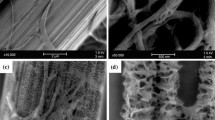Abstract
Polyacrylonitrile (PAN) fiber is an important precursor fiber for high performance carbon fiber. The properties of the final carbon fiber depend strongly on the nature of the PAN fibers. The PAN fibrils were separated successfully from fibers by ultrasonic etching and were systematically investigated by field emission scanning electron microscopy (FESEM) and high resolution transmission electron microscopy (HRTEM). It is found that in certain ultrasonic etching conditions (at 75±2°C for 6 h with a frequency of 40 kHz) the PAN fibers are dissolved in the 95 wt.% aqueous dimethylsulphoxide (DMSO) solution; the fibrils consisting of numerous periodic lamellae with thickness of 30–45 nm and perpendicular to the fiber axis are separated in the 90 wt.% aqueous DMSO solution; and the fibrils with smooth surface exfoliated from the PAN fibers are obtained in the 70–90 wt.% aqueous DMSO solutions. Inner periodical structure of fibrils was observed in HRTEM, which indicates that there are different densities and two phases in fibrils. The PAN fibers are dissolved layer by layer with increasing ultrasonic etching time. The fiber surface experiences ultrasonic cleaning, selective etching, excessive etching and dissolution, and then the sublayer experiences the same process. There are numerous periodic lamellae in fibrils of nascent fibers. This means that the fibrils with lamellae are formed by orientation and crystallization in shearing field of spinning pipe and drawing stress field of coagulation bath.
Similar content being viewed by others
References
Gupat A K, Paliwal D K, Bajaj P. Acrylic precursors for carbon fibers. J Macromolec Sci, 1991, C31: 1–89
Liu X D, Ruland W. X-ray studies on the structure of polyacrylonitrile fibers. Macromolecules, 1993, 26: 3030–3036
Bai Y J, Wang C G, Lun N, et al. HRTEM microstructures of PAN precursor fibers. Carbon, 2006, 44: 1773–1778
Han S, Xu L, Cao W, et al. X-ray diffraction studies on crystalline structure of PAN precursors (in Chinese). J Beijing Univ Chem Technol, 2005, 32: 63–67
Xu Q, Xu L, Cao W, et al. A study on the orientation structure and mechanical properties of polyacrylonitrile precursors (in Chinese). Poly Adv Technol, 2005, 16: 642–645
Sawai D, Fujii Y, Kanamoto T. Development of oriented morphology and tensile properties upon superdrawing of solution-spun fibers of ultra-high molecular weight poly(acrylonitrile). Polymer, 2006, 47: 4445–4453
Iovleva M M, Banduryan S I, Zlatoustova L A, et al. Morphology of the structure of polyacrylonitrile fibers. Fibre Chem, 1999, 31: 140–142
He F, Yang Y, Wang R. Studying the surface weakness of PAN precursor by SEM (in Chinese). Hi-tech Fiber& Appl, 2002, 27: 28–32
Dong Y. Polymer Analysis Handbook (in Chinese). Beijing: China Petrochemical Press, 2004. 479
Michler G H. Electron Microscopy of Polymers. Berlin: Springer, 2008. 186–191
Wang Q, Wang C, Yu M, et al. Effect of ultrasonic etching on the structure and properties of polyacrylonitrile fibers (in Chinese). J Funct Mater, 2010, 41: 155–158
Du W, Chen H, Xu H, et al. Homogeneity of the PAN/DMSO/H2O spinning solutions. Fibers and Polymers, 2009, 10: 290–294
Hinrichsen G, Orth H. Direct evidence of colloidal structure of drawn polyacrylonitrile. J Poly Sci, Part B, 1971, 9: 529–531
Warner S B, Uhlmann D R. Oxidative stabilization of acrylic fibres. J Mater Sci, 1979, 14: 1893–1900
Somani R H, Hsiao B S, Nogales A, et al. Structure development during shear flow-induced crystallization of i-PP. Macromolecules, 2000, 33: 9385–9394
Author information
Authors and Affiliations
Corresponding author
Additional information
This work was supported by the National Natural Science Foundation of China (Grant No. 50673052), the Major State Basic Research Development Program of China (973 Program) (Grant No. 2006CB605314), and the Provincial Natural Science Foundation of Shandong Province (Grant No. Z2008F02).
Rights and permissions
About this article
Cite this article
Wang, Q., Wang, C., Yu, M. et al. Microstructure of fibrils separated from polyacrylonitrile fibers by ultrasonic etching. Sci. China Technol. Sci. 53, 1489–1494 (2010). https://doi.org/10.1007/s11431-010-3142-1
Received:
Accepted:
Published:
Issue Date:
DOI: https://doi.org/10.1007/s11431-010-3142-1




